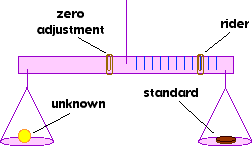![]()
![]()
Generally any measuring device needs to be calibrated to be useful. Calibration is the process where the measuring device is compared to standard units. Standard units are of value because they are also understood and used by other people. The most useful units are those used worldwide. If you are not familiar with the System International, often abbreviated SI, read details about those standard units.
The SI unit for mass is the kilogram. One liter (roughly one quart) of water has the mass of one kilogram (abbreviated kg). If that is too large a unit, the gram is 1/1000 as large.
You may borrow or purchase a set of masses that have already been calibrated. If you purchase a balance, it generally will have been calibrated by the manufacture. If you use a computer-based balance, the software likely includes a calibration file. So why learn about calibration? Measuring instruments, like musical instruments, get out of tune and needs to have their calibration checked or revised periodically. Depending on the balance you plan to use, the procedure varies: a student-made balance, a purchased mechanical balance, or an electronic balance.
 Create a rider. The rider itself should be something like a paper clip or piece of wire that has a mass slightly more than your base standard mass. It is folder over the balance beam so that it can be slid closer or further from the fulcrum on the same side of the balance that will be used to hold the standard masses. Due to leverage, the rider will balance small amounts of mass between zero and the smallest of your standard masses. [Actually you might need TWO paper clips or equivalent. One will be used as the rider, and the second to be left unmoved on the other side of the fulcrum as a counterweight and zero adjustment to compensate when out of balance due to wear.] To calibrate the rider, determine where the rider needs to be to balance your otherwise unloaded balance, then mark that location with a permanent marker. Load your base standard mass [penny or your choice of standard] as if it were an unknown mass, slide the rider outward until it just balances your base standard, then mark that second location. Measure the distance between the two marks with a ruler. Mathematically divide that distance by ten, and mark each tenth on the beam in the gap between the rider for zero and one unit locations.
Create a rider. The rider itself should be something like a paper clip or piece of wire that has a mass slightly more than your base standard mass. It is folder over the balance beam so that it can be slid closer or further from the fulcrum on the same side of the balance that will be used to hold the standard masses. Due to leverage, the rider will balance small amounts of mass between zero and the smallest of your standard masses. [Actually you might need TWO paper clips or equivalent. One will be used as the rider, and the second to be left unmoved on the other side of the fulcrum as a counterweight and zero adjustment to compensate when out of balance due to wear.] To calibrate the rider, determine where the rider needs to be to balance your otherwise unloaded balance, then mark that location with a permanent marker. Load your base standard mass [penny or your choice of standard] as if it were an unknown mass, slide the rider outward until it just balances your base standard, then mark that second location. Measure the distance between the two marks with a ruler. Mathematically divide that distance by ten, and mark each tenth on the beam in the gap between the rider for zero and one unit locations.Describe your calibration efforts and experiences in your science journal. Write a Formal Report if you need to earn credit.
Check the calibration of the balance when you first use a balance and periodically thereafter, depending on the importance of the accuracy of your measurements. To do that, you will need to borrow, purchase, or find a primary standard. It may be easiest to search the kitchen or grocery store for several appropriate sized packages which you have some confidence are close to their labelled masses. Use the balance to weigh the packages pretending you don't known the labelled masses to avoid prejudice. The calibration should be checked over the range of the balance from nearly zero to the maximum.
Record your calibration results in your science journal and write a Formal Report if you need to earn credit.
Inexpensive electronic balances generally do not actually measure mass, but rather an electrical signal which depends on gravitational force. The balance's calibration is stored as a small computer file listing the electrical signal and the correlated mass. Check the calibration of the balance when you first use an electronic balance and periodically thereafter, depending on the importance of the accuracy of your measurements, and make a new calibration file if needed. To do that, you will need to borrow or purchase a primary standard. It may be easiest to search the kitchen or grocery store for several appropriate sized packages which you have some confidence are close to their labelled masses. Using the existing calibration file, weigh the packages pretending you don't known the labelled masses to avoid prejudice. The calibration should be checked over the range of the balance from nearly zero to the maximum. If your measured masses are significantly different from the standards and you have confidence that your primary standards are accurate, create a new calibration file using the directions provided by the manufacture.
Record your calibration results in your science journal and write a Formal Report if you need to earn credit.